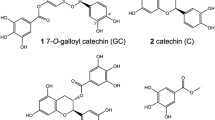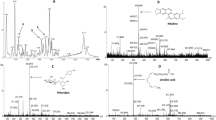Abstract
Purpose
The cucurbitacins are a class of triterpenoid molecules that possess cytotoxic characteristics for plant defense against herbivore feeding. 23,24-dihydrocucurbitacin F (DHCF), a derivative of the cucurbitacin family, has been isolated as an active component from the root of Hemsleya amabilis (Cucurbitaceae), an ancient Chinese remedy for bacillary dysentery, gastroenteritis, and cancers. While the toxicity of other cucurbitacins has been explored in several cancers, little data exist on the effect of DHCF on human cancers, including prostate cancer (PCa). In this study, we explore the level and mechanisms of DHCF toxicity on human PCa cell lines.
Methods
Human PCa DU145, PC3, and LNCaP cells were treated with graded doses of DHCF in vitro, and anti-proliferative, cytotoxic, and proteomic effects were determined using MTS assay, cell cycle analysis, immunofluorescent staining, and western blotting.
Results
DHCF inhibited cell growth and induced cell cycle arrest at G2/M phase, formation of binucleated cells, and increased levels of apoptosis in all PCa cell lines tested. G-actin depletion, actin aggregation, and rod-like actin fibers, with little effect on microtubule structure, were observed after DHCF treatment. Actin aggregation and cofilin-actin rod formation were highly correlated with rapid and persistent dephosphorylation of cofilin-1 (cofilin). DHCF treatment resulted in upregulation of p21Cip1 and downregulation of cyclin A in all three PCa cell lines.
Conclusions
The anti-proliferative activity of DHCF on human PCa cells may be brought about by inducing actin aggregation and cofilin-actin rod formation, leading to cell cycle arrest, cytokinesis failure, and apoptosis.







Similar content being viewed by others
References
Duncan KL, Duncan MD, Alley MC, Sausville EA (1996) Cucurbitacin E-induced disruption of the actin and vimentin cytoskeleton in prostate carcinoma cells. Biochem Pharmacol 52:1553–1560
Jayaprakasam B, Seeram NP, Nair MG (2003) Anticancer and antiinflammatory activities of cucurbitacins from Cucurbita andreana. Cancer Lett 189:11–16
Haritunians T, Gueller S, Zhang L, Badr R, Yin D, Xing H, Fung MC, Koeffler HP (2008) Cucurbitacin B induces differentiation, cell cycle arrest, and actin cytoskeletal alterations in myeloid leukemia cells. Leuk Res 32:1366–1373
Su Y, Li G, Zhang X, Gu J, Zhang C, Tian Z, Zhang J (2008) JSI-124 inhibits glioblastoma multiforme cell proliferation through G2/M cell cycle arrest and apoptosis augment. Cancer Biol Ther 7:1243–1249
Yin D, Wakimoto N, Xing H, Lu D, Huynh T, Wang X, Black KL, Koeffler HP (2008) Cucurbitacin B markedly inhibits growth and rapidly affects the cytoskeleton in glioblastoma multiforme. Int J Cancer 123:1364–1375
Lui VW, Yau DM, Wong EY, Ng YK, Lau CP, Ho Y, Chan JP, Hong B, Ho K, Cheung CS, Tsang CM, Tsao SW, Chan AT (2009) Cucurbitacin I elicits anoikis sensitization, inhibits cellular invasion and in vivo tumor formation ability of nasopharyngeal carcinoma cells. Carcinogenesis 30:2085–2094
Boykin C, Zhang G, Chen YH, Zhang RW, Fan XE, Yang WM, Lu Q (2011) Cucurbitacin IIa: a novel class of anti-cancer drug inducing non-reversible actin aggregation and inhibiting survivin independent of JAK2/STAT3 phosphorylation. Br J Cancer 104:781–789
Zhang Y, Ouyang D, Xu L, Ji Y, Zha Q, Cai J, He X (2011) Cucurbitacin B induces rapid depletion of the G-actin pool through reactive oxygen species-dependent actin aggregation in melanoma cells. Acta Biochim Biophys Sin (Shanghai) 43:556–567
Yang L, Wu S, Zhang Q, Liu F, Wu P (2007) 23,24-Dihydrocucurbitacin B induces G2/M cell-cycle arrest and mitochondria-dependent apoptosis in human breast cancer cells (Bcap37). Cancer Lett 256:267–278
Li Y, Wang R, Ma E, Deng Y, Wang X, Xiao J, Jing Y (2010) The induction of G2/M cell-cycle arrest and apoptosis by cucurbitacin E is associated with increased phosphorylation of eIF2α in leukemia cells. Anticancer Drugs 21:389–400
Yasuda S, Yogosawa S, Izutani Y, Nakamura Y, Watanabe H, Sakai T (2010) Cucurbitacin B induces G2 arrest and apoptosis via a reactive oxygen species-dependent mechanism in human colon adenocarcinoma SW480 cells. Mol Nutr Food Res 54:559–565
Ouyang D, Zhang Y, Xu L, Li J, Zha Q, He X (2011) Histone deacetylase inhibitor valproic acid sensitizes B16F10 melanoma cells to cucurbitacin B treatment. Acta Biochim Biophys Sin (Shanghai) 43:487–495
Maloney KN, Fujita M, Eggert US, Schroeder FC, Field CM, Mitchison TJ, Clardy J (2008) Actin-aggregating cucurbitacins from Physocarpus capitatus. J Nat Prod 71:1927–1929
Chen W, Nieh S, Chen Y, Hsia K (1975) The structures of cucurbitacin IIa and IIb from Hemsleya amabilis. Acta Chim Sin 33:49–56
Wu J, Wu Y, Yang BB (2002) Anticancer activity of Hemsleya amabilis extract. Life Sci 71:2161–2170
Nakashima S, Matsuda H, Kurume A, Oda Y, Nakamura S, Yamashita M, Yoshikawa M (2010) Cucurbitacin E as a new inhibitor of cofilin phosphorylation in human leukemia U937 cells. Bioorg Med Chem Lett 20:2994–2997
Ouyang DY, Ji YH, Saltis M, Xu LH, Zhang YT, Zha QB, Cai JY, He XH (2011) Valproic acid synergistically enhances the cytotoxicity of gossypol in DU145 prostate cancer cells: an iTRAQ-based quantitative proteomic analysis. J Proteomics 74:2180–2193
Bamburg JR, Bernstein BW (2010) Roles of ADF/cofilin in actin polymerization and beyond. F1000 Biol Rep 2: 62
Huang TY, DerMardirossian C, Bokoch GM (2006) Cofilin phosphatases and regulation of actin dynamics. Curr Opin Cell Biol 18:26–31
Besson A, Dowdy SF, Roberts JM (2008) CDK inhibitors: cell cycle regulators and beyond. Dev Cell 14:159–169
Knecht DA, LaFleur RA, Kahsai AW, Argueta CE, Beshir AB, Fenteany G (2010) Cucurbitacin I inhibits cell motility by indirectly interfering with actin dynamics. PLoS One 5:e14039
Huang TY, Minamide LS, Bamburg JR, Bokoch GM (2008) Chronophin mediates an ATP-sensing mechanism for cofilin dephosphorylation and neuronal cofilin-actin rod formation. Dev Cell 15:691–703
Nishida E, Iida K, Yonezawa N, Koyasu S, Yahara I, Sakai H (1987) Cofilin is a component of intranuclear and cytoplasmic actin rods induced in cultured cells. Proc Natl Acad Sci USA 84:5262–5266
Bamburg JR, Bernstein BW, Davis RC, Flynn KC, Goldsbury C, Jensen JR, Maloney MT, Marsden IT, Minamide LS, Pak CW, Shaw AE, Whiteman I, Wiggan O (2010) ADF/Cofilin-actin rods in neurodegenerative diseases. Curr Alzheimer Res 7:241–250
Minamide LS, Striegl AM, Boyle JA, Meberg PJ, Bamburg JR (2000) Neurodegenerative stimuli induce persistent ADF/cofilin-actin rods that disrupt distal neurite function. Nat Cell Biol 2:628–636
Cichon J, Sun C, Chen B, Jiang M, Chen XA, Sun Y, Wang Y, Chen G (2012) Cofilin aggregation blocks intracellular trafficking and induces synaptic loss in hippocampal neurons. J Biol Chem 287:3919–3929
Jang DH, Han JH, Lee SH, Lee YS, Park H, Lee SH, Kim H, Kaang BK (2005) Cofilin expression induces cofilin-actin rod formation and disrupts synaptic structure and function in Aplysia synapses. Proc Natl Acad Sci USA 102:16072–16077
Davis RC, Marsden IT, Maloney MT, Minamide LS, Podlisny M, Selkoe DJ, Bamburg JR (2011) Amyloid beta dimers/trimers potently induce cofilin-actin rods that are inhibited by maintaining cofilin-phosphorylation. Mol Neurodegener 6:10
Mohapatra S, Chu B, Zhao X, Pledger WJ (2005) Accumulation of p53 and reductions in XIAP abundance promote the apoptosis of prostate cancer cells. Cancer Res 65:7717–7723
Cox LS, Lane DP (1995) Tumour suppressors, kinases and clamps: how p53 regulates the cell cycle in response to DNA damage. BioEssays 17:501–508
Harper JW, Elledge SJ, Keyomarsi K, Dynlacht B, Tsai LH, Zhang P, Dobrowolski S, Bai C, Connell-Crowley L, Swindell E, Fox MP, Wei N (1995) Inhibition of cyclin-dependent kinases by p21. Mol Biol Cell 6:387–400
Acknowledgments
This study was supported by grants from the National Natural Science Foundation of China (No. 81173604), the Major State Basic Research Development Program of China (973 Program) (No. 2010CB833603) and the Specialized Research Program of “Twelfth Five-Year Plan” of China (No. 2011ZX09307-303-03).
Author information
Authors and Affiliations
Corresponding author
Additional information
Shuai Ren and Dong-Yun Ouyang contributed equally to this work.
Rights and permissions
About this article
Cite this article
Ren, S., Ouyang, DY., Saltis, M. et al. Anti-proliferative effect of 23,24-dihydrocucurbitacin F on human prostate cancer cells through induction of actin aggregation and cofilin-actin rod formation. Cancer Chemother Pharmacol 70, 415–424 (2012). https://doi.org/10.1007/s00280-012-1921-z
Received:
Accepted:
Published:
Issue Date:
DOI: https://doi.org/10.1007/s00280-012-1921-z




